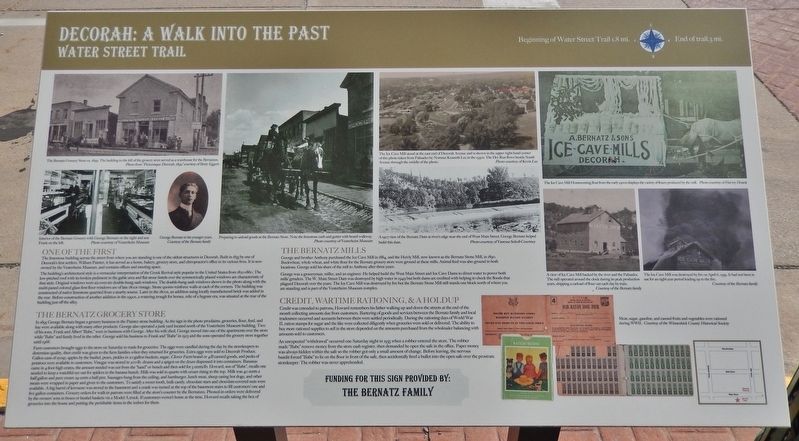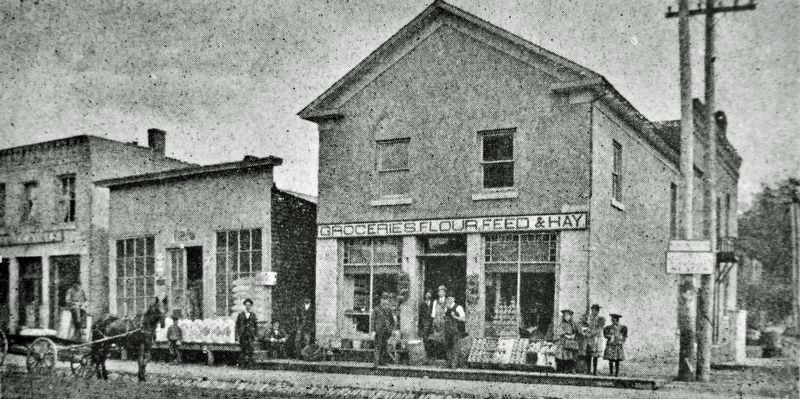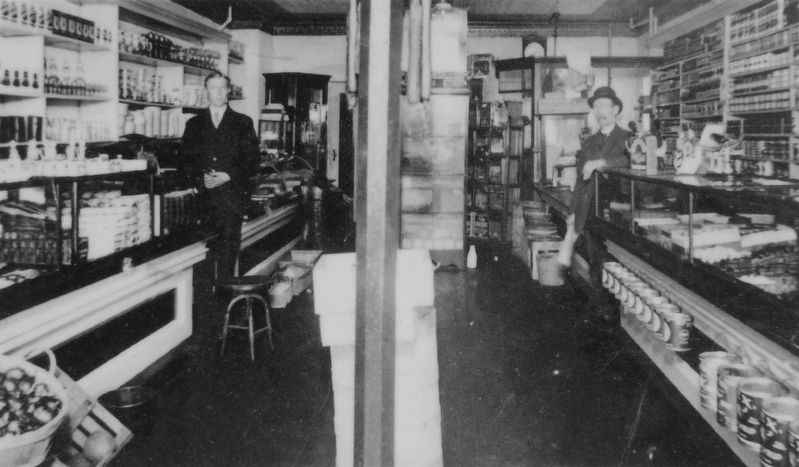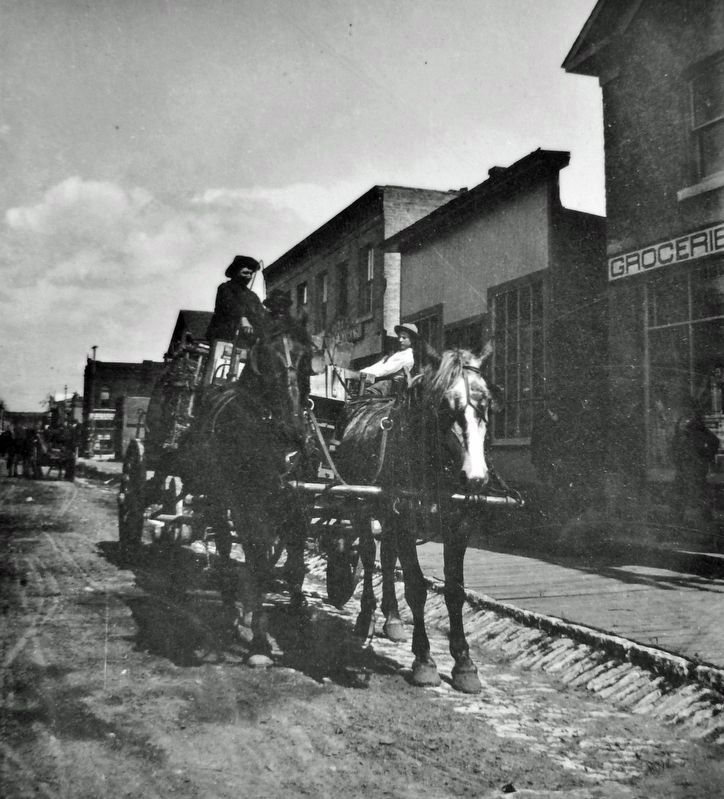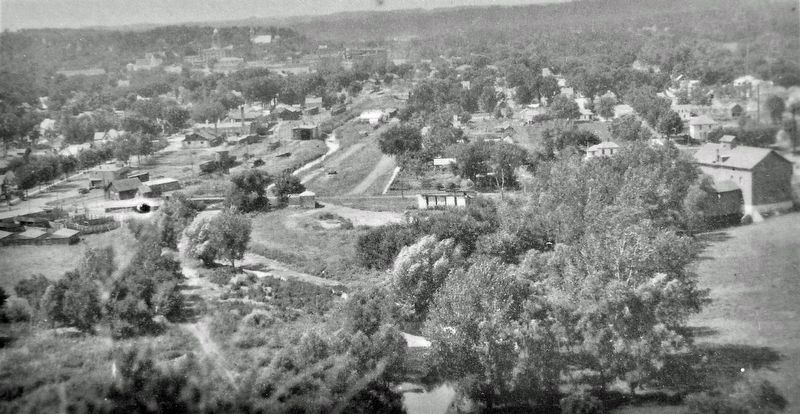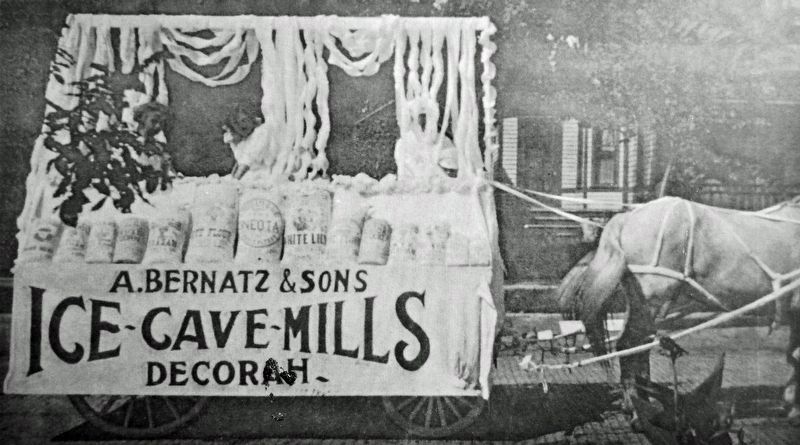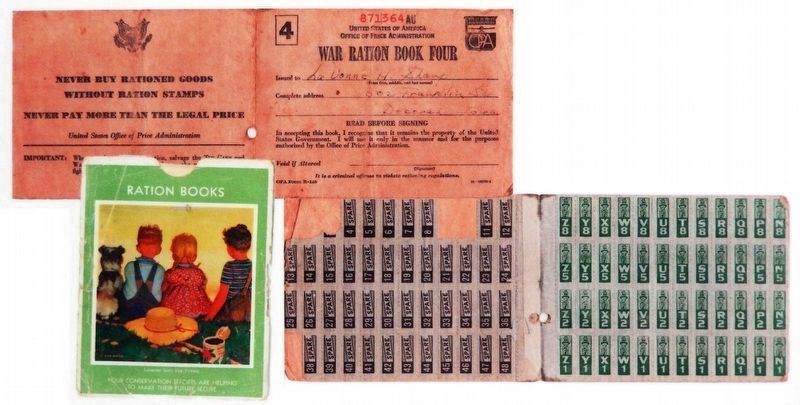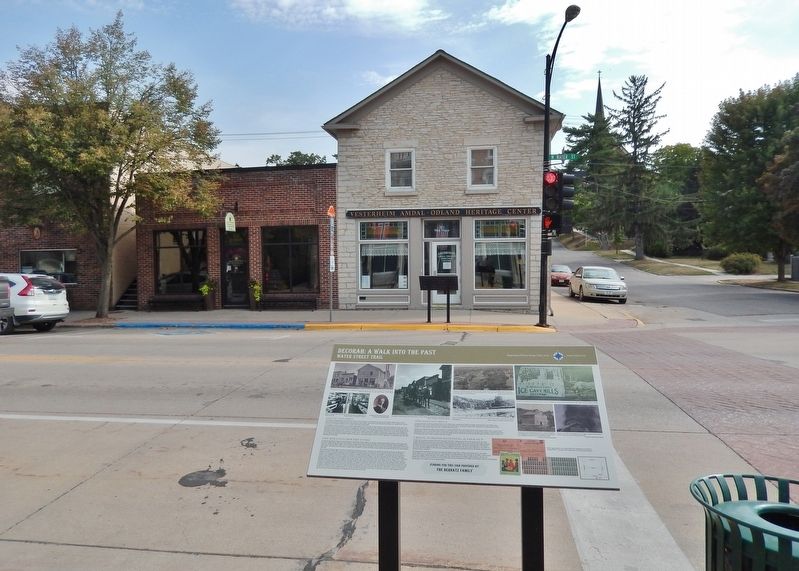Decorah in Winneshiek County, Iowa — The American Midwest (Upper Plains)
Decorah: A Walk into the Past
Water Street Trail
One of the First
The limestone building across the street from where you are standing is one of the oldest structures in Decorah. Built in 1855 by one of Decorah's first settlers, William Painter, it has served as a home, bakery, grocery store, and chiropractor's office in its various lives. It is now owned by the Vesterheim Museum, and contains offices and meeting space.
The building's architectural style is a vernacular interpretation of the Greek Revival style popular in the United States from 1820-1860. The low-pitched roof with its broken pediment in the gable area and flat stone lintels over the symmetrically placed windows are characteristic of that style. Original windows were six-over-six double-hung sash windows. The double-hung sash windows shown in the photo along with the multi-paned colored glass first floor windows are of late 1800s vintage. Stone quoins reinforce walls at each of the corners. The building was constructed of native limestone quarried from a nearby source. Later in the 1800s, an addition using locally manufactured brick was added in the rear. Before construction of another addition in the 1990s, a watering trough for horses, relic of a bygone era, was situated at the rear of the building just off the alley.
The Bernatz Grocery Store
In 1895 George Bernatz began a grocery business in the Painter stone building. As the sign in the photo proclaims, groceries, flour, feed and hay were available along with many other products. George also operated a junk yard located north of the Vesterheim Museum building. Two of his sons, Frank and Albert "Babe," were in business with George. After his wife died, George moved into one of the apartments over the store while "Babe" and family lived in the other. George sold his business to Frank and "Babe" in 1923 and the sons operated the grocery store together until 1968.
Farm customers brought eggs to the store on Saturday to trade for groceries. The eggs were candled during the day by the storekeepers to determine quality, then credit was given to the farm families when they returned for groceries. Extra eggs were sold to Decorah Produce. Gallon cans of syrup, apples by the bushel, pears, pickles in 20-gallon buckets, sugar, Clover Farm brand or 4B canned goods, and pecks of potatoes were available to customers. Vinegar was stored in 200-lb. drums and a spigot on the drum dispensed it into containers. Bananas came in 4-foot high crates; the amount needed was cut from the "hand" or bunch and then sold for 5 cents/lb. Howard, son of “Babe,” recalls one needed to keep a watchful eye out for spiders in the banana bunch. Milk was sold in quarts with cream rising to the top.
Milk was 40 cents a half gallon and pure cream 29 cents a half pint. Sausages hung from the ceiling, and hamburger, lunch meat, sheep casing hot dogs, and other meats were wrapped in paper and given to the customers. To satisfy a sweet tooth, bulk candy, chocolate stars and chocolate-covered nuts were available. A big barrel of kerosene was stored in the basement and a crank was turned at the top of the basement stairs to fill customers' one and five gallon containers. Grocery orders for walk-in patrons were filled at the stores counter by the Bernatzes. Phoned-in orders were delivered by the owners' sons in boxes or bushel baskets via a Model A truck. If customers weren't home at the time, Howard recalls taking the box of groceries into the house and putting the perishable items in the icebox for them.
The Bernatz Mills
George and brother Anthony purchased the Ice Cave Mill in 1884, and the Heivly Mill, now known as the Bernatz Stone Mill, in 1890. Buckwheat, whole wheat, and white flour for the Bernatz grocery store were ground at these mills. Animal feed was also ground in both locations. George sold his share of the mill to Anthony after three years.
George was a groceryman, miller, and an engineer. He helped build the West Main Street and Ice Cave Dams to direct water to power both mills’ grinders. The W. Main Street Dam was destroyed by
high water in 1949 but both dams are credited with helping to check the floods that plagued Decorah over the years. The Ice Cave Mill was destroyed by fire but the Bernatz Stone Mill still stands one block north of where you are standing and is part of the Vesterheim Museum complex.
Credit, Wartime Rationing, & a Holdup
Credit was extended to patrons; Howard remembers his father walking up and down the streets at the end of the month collecting amounts due from customers. Bartering of goods and services between the Bernatz family and local tradesmen occurred and accounts between them were settled periodically. During the rationing days of World War II, ration stamps for sugar and the like were collected diligently when groceries were sold or delivered. The ability to buy more rationed supplies to sell in the store depended on the amounts purchased from the wholesaler balancing with amounts sold to customers.
An unexpected "withdrawal" occurred one Saturday night in 1935 when a robber entered the store. The robber made "Babe" remove money from the store cash register, then demanded he open the safe in the office. Paper money was always hidden within the safe so the robber got only a small amount of change. Before leaving, the nervous bandit forced "Babe" to lie on the floor in front of the safe, then accidentally fired a bullet into the open
safe over the prostrate storekeeper. The robber was never apprehended.
[other photo captions]
• George Bernatz in his younger years.
• A 1907 view of the Bernatz Dam at river’s edge near the end of West Main Street. George Bernatz helped build this dam.
Funding for this sign provided by: The Bernatz Family
Topics. This historical marker is listed in these topic lists: Architecture • Industry & Commerce • Settlements & Settlers • War, World II. A significant historical year for this entry is 1855.
Location. 43° 18.255′ N, 91° 47.52′ W. Marker is in Decorah, Iowa, in Winneshiek County. Marker is at the intersection of West Water Street and North Mill Street, on the right when traveling west on West Water Street. The marker is located along the sidewalk, near the northeast corner of the intersection. Touch for map. Marker is at or near this postal address: 520 West Water Street, Decorah IA 52101, United States of America. Touch for directions.
Other nearby markers. At least 8 other markers are within walking distance of this marker. A different marker also named Decorah: A Walk into the Past (a few steps from this marker); Welcome to Vesterheim (a few steps from this marker); Vesterheim (within shouting distance of this marker); Norsvin Mill (within shouting distance of this marker); Egge-Koren House (within shouting distance
of this marker); Valders House (within shouting distance of this marker); Bethania Church (within shouting distance of this marker); Stabbur (within shouting distance of this marker). Touch for a list and map of all markers in Decorah.
Related markers. Click here for a list of markers that are related to this marker.
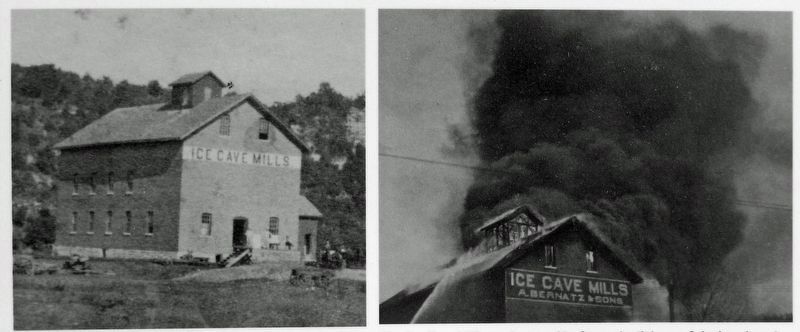
Courtesy Bernatz Family
7. Marker detail: Ice Cave Mill
left: A view of Ice Cave Mill backed by the river and the Palisades. The mill operated around the clock during its peak production years, shipping a carload of flour out each day by train.
right: The Ice Cave Mill was destroyed by fire on April 6, 1939. It had not been in use for an eight-year period leading up to the fire.
Credits. This page was last revised on January 27, 2024. It was originally submitted on January 25, 2024, by Cosmos Mariner of Cape Canaveral, Florida. This page has been viewed 52 times since then. Photos: 1, 2, 3, 4, 5, 6. submitted on January 26, 2024, by Cosmos Mariner of Cape Canaveral, Florida. 7, 8, 9. submitted on January 27, 2024, by Cosmos Mariner of Cape Canaveral, Florida.
